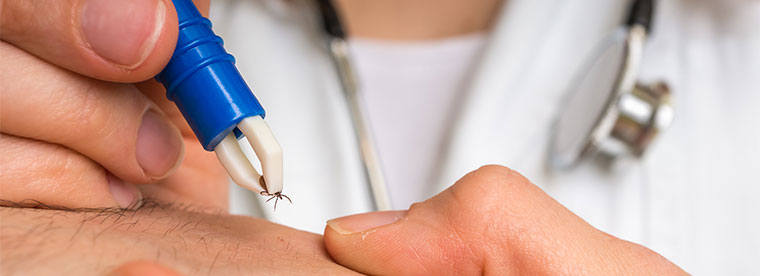Rocky Mountain spotted fever
The first symptoms of Rocky Mountain spotted fever, spread by the brown dog tick, appear a couple days after the bite and include fever, headache, vomiting and muscle pain. A rash also may develop later in the disease. It will look like small pink spots on the arms and legs.
Ehrlichiosis
Ehrlichiosis, transmitted by the lone star tick, is a name for several less-common bacterial diseases and can cause fever, headache, fatigue and muscle aches. While a rash may develop, it’s not common.
Babesiosis
Some people with this rare deer tick-borne disease don’t experience any symptoms. Others may develop fever, headache, nausea, vomiting and loss of appetite. Babesiosis also can cause a type of anemia that leads to your skin turning yellow (known as jaundice) and dark urine.
Powassan
This virus spread by the deer tick is rare but very serious, as it can cause inflammation of the brain. About 10 percent of people who develop it will die, and half of survivors will have permanent neurological symptoms, such as frequent headaches or memory problems. Early symptoms include fever, headache, weakness and vomiting. Later symptoms can include confusion, loss of coordination or speech difficulties and seizures. There are no medications to treat Powassan directly, and patients may need respiratory support or treatment to reduce swelling in the brain.
While most tick-borne diseases are easily treated with oral antibiotics if caught early, you can become very ill if treatment is delayed. Let your doctor know you’ve spent time outdoors even if you don’t remember being bitten.
You likely won’t feel a tick bite, and the tick may fall off before you spot it, so it’s important to know the symptoms of these illnesses and seek treatment as soon as possible.
How to remove ticks from your skin
If you find a tick on yourself or on your child, don’t panic. There’s likely no need to race to the emergency room. A tick needs to be attached to the body at least 24 hours to transmit most diseases. So if you remove it the same day, you’ll likely be fine.
The best way to remove a tick is to use tweezers to grab it as close to the skin as possible and pull straight out. Don’t twist as you pull, because it can cause the tick’s mouth parts to break off and remain in the skin. Then clean the area with rubbing alcohol or soap and water.
There are a few methods you shouldn’t use:
- Don’t use your fingers: If you crush the tick, you run the risk of the juices spreading on your hands.
- Don’t burn it off: I’ve seen people try to use cigarettes to kill the tick, but they usually just end up with a burn and a tick bite.
- Don’t use Vaseline to smother it: This is a myth. It doesn’t work.
How to prevent tick bites
The best way to prevent illnesses such as Lyme disease is to avoid exposure to ticks. If possible, stay out of wooded or brushy areas. If this isn’t possible, here are some tips to protect yourself and your loved ones.
Tips to repel ticks:
- Use repellent that contains 20 percent or more DEET or picaridin on any exposed skin. The Environmental Protection Agency has a tool to help you find the best repellent for you and your family.
- Treat clothes with products that contain permethrin, an insecticide.
- Wear long sleeves and pants.
- Tuck your pants legs into your socks.
- Treat your pets with flea and tick collars, sprays or topical treatments to avoid them bringing ticks home with them.
Tips to find ticks on your body and clothing:
- Check every inch of your body after spending time outdoors. Don’t forget around your ears, the backs of knees and elbows, armpits and hairlines. Do the same for your pets.
- Take a shower within a couple hours of spending time outside. Ticks tend to wander around a bit before attaching, and you may be able to wash them off before they attach. This is also a good time to do a tick check.
- Don’t forget about your clothes. Throw them in the dryer on high heat for 10 minutes to kill any hiding ticks.
Ticks will return every year. And we must remain vigilant to prevent tick bites and notice the symptoms of tick-borne diseases as soon as they appear.
Sign up to get the latest health news and information, along with health and wellness tips, sent directly to your inbox.

